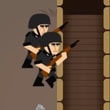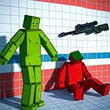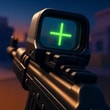The elevator is broken and good, because you were never going to wait. You tighten your gloves, stare at the tile beneath your feet, and jump straight through it like gravity just dared you. Smashdoll is chaos with manners, a ragdoll descent where every floor is both obstacle and invitation, every bounce is a joke you finish with your shoulder, and every second is a negotiation with gravity you absolutely intend to win. It’s fast, it’s ridiculous, and it has the one thing any falling game needs more than height: rhythm.
💥 First impact, first grin
The opening drop is a polite shove. You punch through a plank, ricochet off a support beam, and land in a room full of breakables arranged like a buffet. You learn the basics without reading a thing. Tilt for angle, tap for a micro hop, hold just long enough to load weight into the next slam. Wood sighs, glass sings, metal complains, and somewhere a coin line draws a smile you can’t outrun. Your ragdoll flails in the most cinematic way possible and still manages to look purposeful, like a gymnast whose coach is gravity and whose routine is violence. Each floor teaches by sound, not by lecture, and the moment the feedback clicks you start planning three breaks ahead.
🧲 Coins, bullets, and the dance of risk
The air is packed with temptations and insults. Coins coil into spirals that sit a little to the left of safe. Turrets track lazily, then snap awake when you drift too long in one lane, their bullets more heckle than horror until they stack into trouble. Spiked girders hang at rude angles and ask if you remember to breathe while you thread them. You don’t win by hiding; you win by surfing all of it with small, confident inputs. Duck through a laser gap, kiss a coin ribbon, then commit to a floor break at a diagonal that makes the next two rooms line up like you meant it. The best runs feel greedy and controlled at the same time, like you’re stealing time itself and tipping well on the way out.
🔋 The meter, the monster, the moment
Every impact feeds the Smash Meter, a bright, impatient bar that wants only one thing: to let you become nonsense. When it fills, the world softens for a tick, the soundstage drops a hungry bass note, and you pop into Smash Mode—a streaking projectile that ignores self-doubt, ricochets like a pinball with opinions, and erases floors faster than the camera can brag about it. This is not god mode. It is permission to be rude. Aim for thick sections. Hop if you must, but mostly draw a line that future you can farm for coins once the glow fades. The timing is a habit you’ll learn by feel: trigger too early and you waste meter on tissue; trigger too late and you kiss a turret instead of its power core. When you nail it, the descent becomes a one-sentence poem that starts with now and ends with wow.
🛠️ Upgrades that change how you move, not just how big numbers get
Between dives, the workshop door swings open and the game winks. Smash power is the obvious buy, and yes, bigger hits turn stubborn floors into polite suggestions. But jump force is the secret handshake—more lift means better mid-air edits, the little hops that convert ugly angles into beautiful lines. Trail mods are flair and function; a comet shimmer makes distance reads clearer, a smoke curl exaggerates your arc so you correct earlier, a neon ribbon simply makes success look like it should cost tickets. Magnet tweaks pull distant coins into your orbit if your line is honest; shield charms forgive exactly one outrageous mistake per run and feel like applause when they pop. You don’t drown in menus. You pick a flavor, you feel the difference, you go again.
🌀 Rooms with moods and the pleasure of recognition
Floors aren’t random soup. They have personalities that repeat just enough for mastery to feel like memory. Warehouse chambers stack crates into steps that reward diagonal slams and patient hops. Atrium wells are smooth, vertical shafts with glass bridges that shatter into safe slopes if you hit them off-center; miss the angle, and you’ll learn to love regret. Reactor zones hide coin rings behind destructible panels, so you plan a two-step: break the guard, then harvest the swirl. The deeper you go, the more the game expects you to be brave with purpose, and you will be, because nothing feels better than setting up a three-room sequence from one smart bounce.
⚙️ Physics you can trust, comedy you can steer
Ragdoll means wobble, but Smashdoll’s wobble is generous. Momentum carries naturally; rotations bleed off predictably; friction on surfaces is a personality you learn by touch. You’ll start using hips to steer, shoulders to clip, knees to cushion, and forehead to sign important paperwork. A short hop resets a bad spin. A longer hold pulls you into a fast dive that drills clean through a stubborn plate. If you smack a corner at speed, watch how the rebound angles into a lane that is either disaster or destiny depending on whether you breathe. It’s slapstick physics with a kind teacher, and once it’s in your hands you’ll stop blaming the engine and start writing your own stunts.
🎯 Micro goals that stack into swagger
Every run contains three tiny promises. Get to the next checkpoint with meter to spare. Grab the greedy coin cluster you skipped last time. Leave this particular turret with nothing but feelings. Those are five-second missions, and completing them changes your whole posture. The metagame quietly tracks best depth, best coin chain, cleanest room streak, and those little records are the perfect fuel for one-more-fall syndrome. You’ll swear you’re done at midnight and still drop twice more because the run in your head just drew a slightly cleaner diagonal.
🎮 Controls that vanish when flow arrives
On keyboard or gamepad, your left hand paints line and your right hand accents smash timing; there’s no camera wrestling, no crowded HUD yammering over important sounds. On touch, the thumb drag is a surprisingly elegant brush—short strokes to correct, long sweeps to commit, a quick lift to pop the hop. The input curve is forgiving where it should be and strict where it must be. Hesitation skews angles. Confidence lands pay dirt. You’ll feel the difference in your shoulders before you see it on the meter.
🔊 The mix that makes decisions faster
Headphones turn the descent into a concert of useful noises. Wood breaks in warm clacks, glass snaps in bright shards, metal groans with a lower, longer complaint; that timbre tells you how deep to commit on the next touch. Bullets hiss before they arrive; lasers hum in a steady key that maps to their sweep; coin runs chime upward when you enter them correctly and flatten when you stray, a musical hint that your angle needs love. Smash Mode hits like a synth drop, then cools to a purr as the meter empties. The game doesn’t nag. It sings intentions.
🧠 Tiny habits, huge payoffs
Aim for corners, not centers. Floors yield fastest at edges, and the rebound is friendlier. Use hop as punctuation, not panic; the best jumps are quiet commas that keep your sentence readable. Chase coin spirals only when your line already agrees; magnets help, but greed without geometry is how you meet spikes. Trigger Smash Mode right before mixed-material rooms—wood into glass into metal—because multi-breaks snowball meter and speed. When a run tilts, bail a little upward with a hop to reshape the bounce rather than forcing a bad slam. And always, always listen: the level tells you what it wants to be if you stop arguing.
🚀 Why the bottom keeps calling
Because falling this fast somehow feels calm when your inputs are clean. Because upgrades add verbs to your hands instead of just numbers to a card. Because rooms repeat like favorite jokes you deliver better each time. Because that moment when the Smash Meter blooms, the trail turns into a comet, and four floors evaporate in one breath will make you laugh out loud if you’re alone and louder if you aren’t. Mostly because Smashdoll understands that physics is a playground, not a punishment. You break things. Things break beautifully. And on Kiz10, you’re always one click from the next plunge.
 Raftopia
Raftopia













































